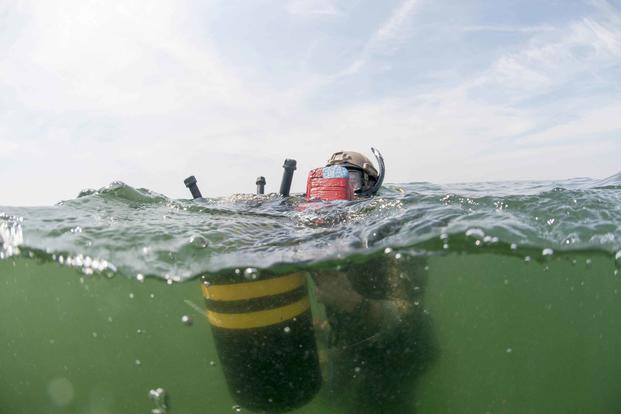The U.S. Navy is considering going to a longer training cycle for explosive ordnance disposal (EOD) sailors, which could feature shorter deployments to potentially give them more time at home.
The proposal to extend the standard 24-month deployment cycle out to as long as 36 months is part of the Navy Explosive Ordnance Disposal Strategic Vision 2030, an effort designed to better prepare the small, highly specialized force for the missions it would face in a large conflict against a major foe.
Navy EOD units have always helped with counter-mine operations for the fleet, but, as part of the new vision, they will take a more aggressive role in using new unmanned-vehicle technology to create safe lanes for naval forces, Capt. Rick Hayes, commodore of Explosive Ordnance Disposal Group Two, told defense reporters at the Pentagon on Wednesday.
"For decades, we would often wait for the ships to do their thing, and the helos to do their thing, and pass [mine] contacts to us for prosecution," he said. "That paradigm has changed now. We own those [unmanned vehicles], we own those search tools as a community now, so that has changed our mindset as well."
Related: New Special Pay, Bonuses May Be Coming for Navy EOD Techs as Mission Evolves
EOD units will also take on a larger role in forensic analysis of potential weapons of mass destruction to find out "who may have built or emplaced that device or trying to investigate where the components of that device may have come from," Hayes said.
The focused, new missions will require a different approach to the training and deployment strategy, said Capt. Oscar Rojas, commodore of Explosive Ordnance Disposal Group One.
"We are completely transforming how we do our training cycle that leads up to a certification deployment," he said. "I tell you -- investing 24 months into a training cycle and only getting one, six-month deployment is a horrible investment."
Over the next "six to eight months," the Navy will study expanding the 24-month cycle to 32 or even 36 months, Rojas said.
"By revamping how we do training, it gives them more time to decompress at home, not only before they deploy but also when they return from deployment. They will have more quality time at home," he said.
The new training plan would be designed to ensure that units are ready for major combat operations by the end of the basic phase of training they go through at the beginning of every cycle, Rojas added.
"So that means they are certified; they are ready to go out the door," he said. "As you shift over to the advanced phase, there becomes more white space to focus on some of the areas platoons found they were deficient in the basic phase, so they can truly put that fine edge on that training during the advanced phase."
EOD sailors would have to do their certification training only once in a 36-month cycle instead of twice in 48 months with the standard 24-month model, so "you actually reduce the time away from home," Rojas said.
The longer schedule would allow units to go on two shorter deployments instead of one six-month deployment, potentially giving them more time at home, he said.
"As we look at this analysis, the traditional six-month deployment that we do, potentially it gets reduced to doing two, four-month deployments," Rojas said. "You do get more time at home than what the current 24-month [optimized fleet response plan] does, and it also gives you enough time to get higher-end training as well."
-- Matthew Cox can be reached at matthew.cox@military.com.
Read more: New Commissary, Exchange Access Delayed for Many Veterans












